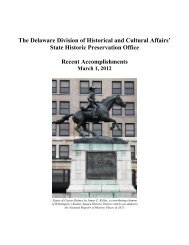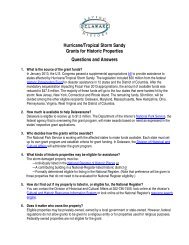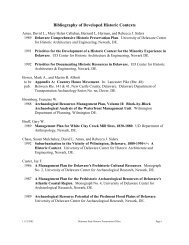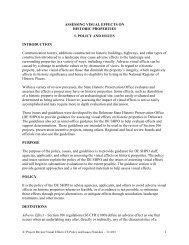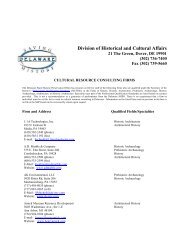Report of the Archaeological Investigations of the New Castle Court ...
Report of the Archaeological Investigations of the New Castle Court ...
Report of the Archaeological Investigations of the New Castle Court ...
Create successful ePaper yourself
Turn your PDF publications into a flip-book with our unique Google optimized e-Paper software.
NEW CASTLE COURT HOUSE PLAZA<br />
NEW CASTLE, DELAWARE<br />
4.0 ARTIFACT ANALYSIS<br />
The analysis <strong>of</strong> ceramics and glass from Feature 20 resulted in <strong>the</strong> identification <strong>of</strong> nine<br />
additional vessels (Plate 21). The intent <strong>of</strong> this section is to provide a more detailed examination<br />
<strong>of</strong> <strong>the</strong> ceramics contained within Feature 20, <strong>the</strong> backfilled cellar hole. Since <strong>the</strong> approximate<br />
date <strong>of</strong> <strong>the</strong> infilling is circa 1674-1725, this examination will focus on <strong>the</strong> ceramics dating from<br />
that time period. The small number <strong>of</strong> creamware, pearlware, and Chinese export fragments are<br />
removed from <strong>the</strong> discussion (see Section 3.5.5).<br />
The following vessels are sparingly represented within <strong>the</strong> assemblage; scant physical remnants<br />
are typical <strong>of</strong> secondary deposits and only tentative remarks about possible form and function are<br />
presented. The preliminary vessel analysis identified three possible milk pans (2 redware, 1<br />
possible Donyatt), a possible Red Border ware skillet or saucepan, a Staffordshire hollowware, a<br />
tin-glazed bowl, a tin-glazed charger, and two tin-glazed flatwares.<br />
Vessel 1, <strong>the</strong> first <strong>of</strong> two redware milk pans, has a measured 9 in. base and a 16 in. rim diameter.<br />
The second example (Vessel 2) measured a slightly narrower 15 in. rim diameter (with an<br />
indeterminately sized base). The paste <strong>of</strong> both vessels is described as coarse with large ochre<br />
inclusions; a clear lead glaze coats <strong>the</strong> interior. Vessel 1 is best represented in terms <strong>of</strong> quantity,<br />
with a dozen fragments extending from its base to <strong>the</strong> rim (contexts 43, 48, and 148), while only<br />
three sherds (2 rims from context 44 and 1 base from context 148) were documented for <strong>the</strong> later<br />
example. The third vessel represents a possible Donyatt or South Somerset milk pan (Kiser 2001;<br />
Pope 1986:103-105). Within its red-orange fabric, large ochre inclusions were, again, identified.<br />
The overall size <strong>of</strong> this vessel is unknown, although an approximate 9 in. base diameter (derived<br />
from a single basal sherd from context 48) was tentatively calculated.<br />
Vessel 4 represents a possible Red Border ware (Pearce 1992) skillet or saucepan, based on a<br />
flanged rim sherd from context 43. The interior <strong>of</strong> this vessel contains a green lead glaze, while a<br />
black oxide residue was still evident on <strong>the</strong> exterior.<br />
The fifth identified vessel is represented by a single Staffordshire body sherd recovered from<br />
context 147. The interior <strong>of</strong> this hollowware vessel is lead glazed, with a slip applied to both <strong>the</strong><br />
interior and exterior sides.<br />
Vessel 6 likely denotes a tin-glazed sweetmeat or high-sided squared bowl. Unfortunately, <strong>the</strong><br />
single tin-glazed rim sherd recovered from context 51 is too small to provide an aperture<br />
measurement. Vessel 7 corresponds to a single recovered tin-glazed ear<strong>the</strong>nware rim sherd from<br />
context 43. This vessel is currently interpreted as a possible charger with an 11 in. rim diameter.<br />
A blue hand-painted representational decoration adorns <strong>the</strong> exterior <strong>of</strong> this o<strong>the</strong>rwise blue-glazed<br />
sherd. The two remaining vessels are probable tin-glazed flatwares (Vessels 8 and 9). The first<br />
example, identified by a body sherd recovered from context 43, has a tin-glazed interior adorned<br />
by a blue hand-painted decoration and a clear glazed exterior. The final vessel is represented by a<br />
base sherd recovered from context 48. This specimen showing very little use wear, is glazed on<br />
both sides, and is distinguished by three parallel blue lines hand-painted on <strong>the</strong> interior (Nöel<br />
Hume 1977).<br />
4.3 CERAMIC VESSEL ANALYSIS FROM FEATURES 23 AND 37<br />
The ceramics derived from two erosion features (23 and 37) identified on <strong>the</strong> eastern portion <strong>of</strong><br />
<strong>the</strong> plaza were also chosen for analysis based on <strong>the</strong>ir relatively early calculated assemblage date<br />
ranges. In total, 18 ceramic vessels were identified from both features. The results <strong>of</strong> this analysis<br />
are presented below.<br />
65





